

Do You Enjoy Travel Stories?
This website chronicles our trip around the world in 2006. It has lots of photos, videos and stories. We invite you to come in, relax and enjoy the scenery.
~Lee and Sachi LeFever
To see what we're up to now, check LeeLeFever.com or CommonCraft.com
Our Recent Dispatches Are Below. 
A Dispatch is a report from our trip. Browse via keywords or global map.
Evidence of Genocide, Phnom Penh, Cambodia
The first memorial is a former school that was turned into a prison when schools were outlawed. The prison was called “S-21” or “Tuol Sleng” and it played a central role in the identification and execution of those accused of treason within the Khmer Rouge itself. Of the over 20,000 people sent to the prison, only 7-12 reportedly survived.
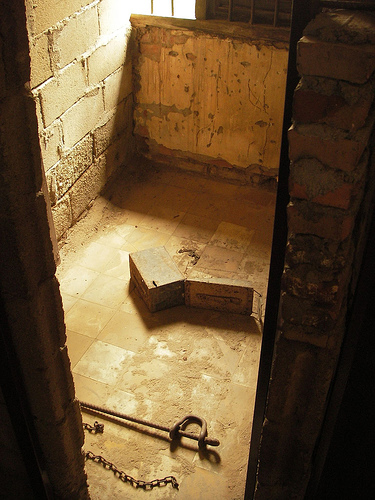
Pol Pot and the others running the show became increasingly paranoid and convinced that CIA and KGB agents were operating within their ranks. Unbelievable means of torture were used to bring out “confessions” including electricity, mutilation and burning. The accused were forced to name other “spies” and faced a choice of naming other innocent people or dying. This created a vicious circle of needless death as these soldiers named one another in an attempt to save their own lives. In the end of course, all involved were executed.
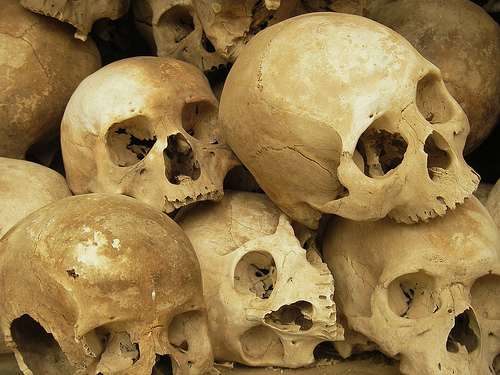
Many of the deaths actually occurred at what is now known as the “Killing Fields” which are mass graves about 30 minutes outside of
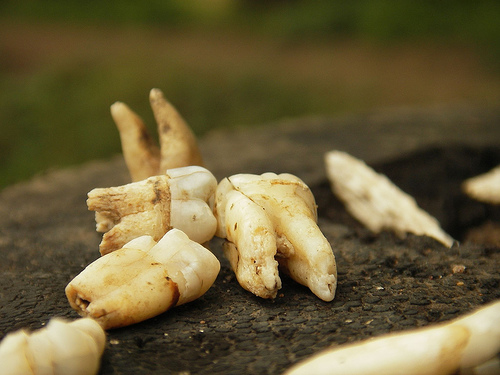
While these memorials are sad, gruesome and effective, I think it is a bit unfortunate that Cambodia is known more for genocide than it's beautiful beaches, waterfalls or incredible ancient ruins. I'm seeing a nation on the rebound who is ready to shed all the baggage and move on.
Pol Pot and his Murderous Khmer Rouge
 Having learned a bit about the Khmer Rouge period of Cambodian history lately via books and visits, I’ve been struggling about what I should share here on TwinF. I want to say so much – too much. I find myself being overwhelmed with interesting, horrifying and heartbreaking stories that a single blog entry cannot do justice. I’ve resolved to focus on just a few points:
Having learned a bit about the Khmer Rouge period of Cambodian history lately via books and visits, I’ve been struggling about what I should share here on TwinF. I want to say so much – too much. I find myself being overwhelmed with interesting, horrifying and heartbreaking stories that a single blog entry cannot do justice. I’ve resolved to focus on just a few points:
- Modern History of Cambodia in 100 words or less
- Only seven Doctors Left
- Year Zero
Modern History of Cambodia in 100 words or less
In 1975 a new Communist government came to power in
Only Seven Doctors Left
I met a Cambodian man in our hotel lobby that was watching BBC World News when a news story came on about the upcoming trial of some now-elderly Khmer Rouge leaders. His name was Dom and he spoke with obvious emotion. I was interested to know his story. In 1975 he was 2 years old (same as me) when Pol Pot came to power. His father, a physician, was immediately separated from the family after being identified by his profession. Dom never saw his father again. The systematic execution of intellectuals was a strategy implemented by the Khmer Rouge. People who were deemed to be educated were potential enemies and enemies had to be “smashed to bits”. When the regime finally crumbled, some estimates conclude that there were only seven physicians left in all of
Year Zero
Pol Pot’s goal was to turn
In talking to Cambodians I heard a theme regarding the Pol Pot time that related to starting over from “Year Zero”. I’m only starting to grasp what it means for
The more I learn about the Khmer Rouge the more unbelievable it seems and I get the feeling that Cambodians that are my age feel the same. I don't get a sense of anger or hatred as much as disbelief. From my own perspective I cannot get past the fact that Pol Pot and his cadre were absolutely convinced that their plan would actually work and would be a good thing for the country. Simply unfathomable.
Kabal Chai Waterfall, Sihanoukville, Cambodia
I sometimes feel like we're talking a bit too much about our activities and not so much about our experience, if you know what I mean. We aim to change that a bit, but for now, an experience we had yesterday deserves a little publication.
Don is a friendly Irish ex-pat that runs Coaster's Bungalows where we're staying in Sihanoukville. Yesterday, Don saw me on our balcony and said, in his Irish accent "Hey! Are you leaving today? We're going out to the waterfall, if you wanna go, meet us at the bar in 30." Waterfall? We had not heard about the waterfall! Upon looking at the guidebooks (Footprint and Rough Guide), no waterfall is mentioned.
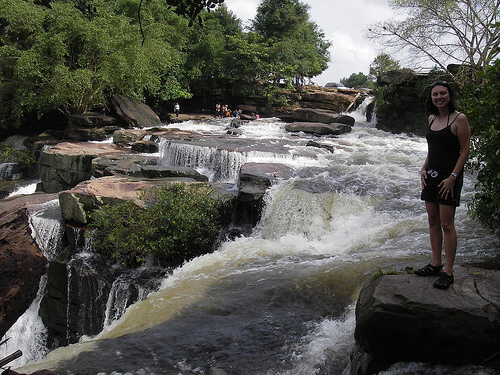
As it turned out, we got to follow along on a waterfall trip with Don and his family (wife Carrie and daughter Anna). After driving for about 30 minutes (including a "shortcut" through barely passable roads") we went down a long dirt road that ended at some shacks and a washed out bridge. After being ferried over the river we came upon a waterfall, or actually a set of waterfalls that were certainly among the best I've ever seen. Given a little more care and infrastructure, the falls have the potential to become a national landmark- they are that impressive.
Situated at the convergence of two rivers, the water falls fall into a basin that appears to have dropped about 10 meters all at once, creating a valley where you are surrounded by waterfalls from two rivers. Stunning.
The highlight is a set of falls that flow off an outcropping, enabling people to climb behind it in short ledges. What a weird feeling. It's a bit like the first time you snorkle and your body has to learn that it can, indeed, breathe underwater. With water flowing over your eyes and mouth and crashing over your head, threatening to grab you and slam you on the rocks below, the experience is a more than a bit breathtaking.
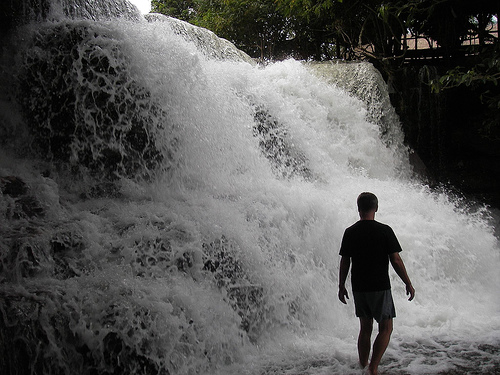

Water rushing by overhead...
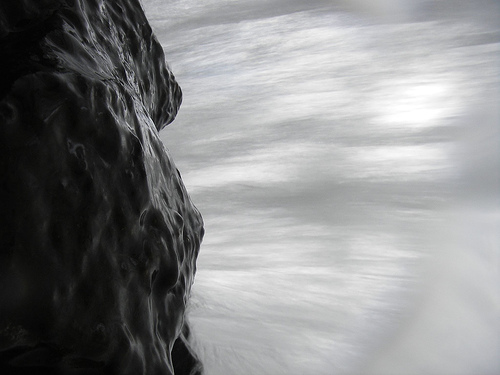
Don, our guide for the day...
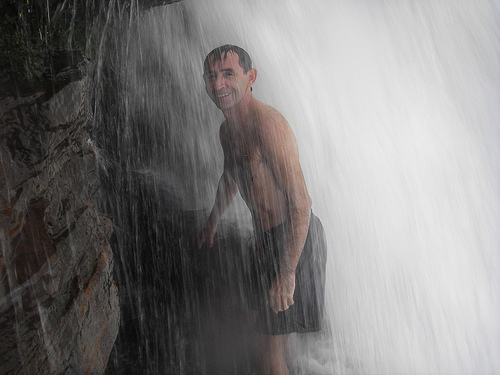
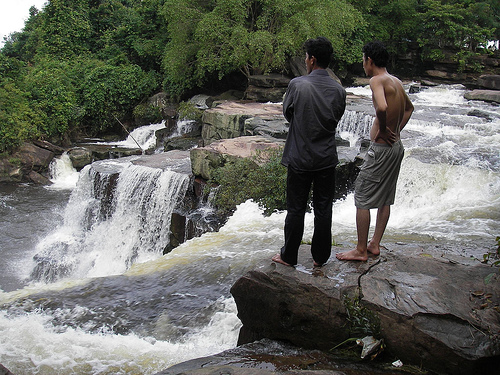
If you want to visit the Kabal Chai falls, ask about it at the guesthouses in Sihanoukville. It is best in the rainy season for obvious reasons and the rivers dwindle to a trickle in the dry season.
A Holiday in Cambodia
Since
It's time to taste what you most fear
Right Guard will not help you here
Brace yourself, my dear
It's a holiday in Cambodia
It's tough kid, but it's life
It's a holiday in Cambodia
Don't forget to pack a wife
The song was published in 1980, just a year after the failure of the Khmer Rouge regime and reflects some of
A holiday in

Don’t get me wrong though,
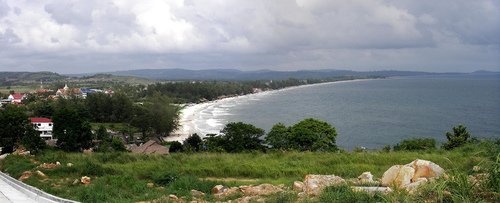
The feeling we get is that Sihanoukville is on the verge of an explosion. People who have grown tired of the scene in
The Laos Dining Experience

Lying between
As we walked by each restaurant and café, staff would inevitably not smile, but would instead stare to see if we chose one of their tables for a meal. Once we sat down, a menu was silently dropped in front of us and the server stood, still without a smile, staring to hear a request.
We understand that cultural cues can be very different between neighboring countries and we assume that restaurant staff in general didn’t feel we were an imposition on their evening, but after coming from
In other Asian countries, I hadn’t felt that need to fall back on Western food, but the local Lao dishes for me seemed to lack much flavor with the exception of straight chilli peppers. We tried more than a few stir fried dishes, curries, spring rolls, meat and sticky rice on sticks, and a few handfuls of market favorites wrapped in banana leaves. It wasn’t nearly as delicious as Thai versions. Even the dipping sauces seemed watery and lacked the salty or sweet richness in flavor the spring rolls needed, though fresh mint added to the rolls were a nice touch. I can see why, at least for foreigners, there were many more cooking schools available for Thai cuisine.
In
Phnom Penh, Cambodia with Mongkol
Before we left

For those that may have seen what I said on a local news story, it was that guidebooks are great, but we’d prefer to meet locals who can give us another perspective on a city and our day with Mongkol did just that. He said “So, do you want to be with the other barangs (foreigners), or go where Cambodians eat?” We left town to “eat boiled corn”.
After about 30 minutes of driving we arrived at a strip of restaurants right on the edge of a marsh. This was no regular restaurant. The kitchen was on the land, but the tables (sitting areas) and roof rambled out over the marsh for about 80 yards on bamboo stilts. With every step, the floor bounced and swayed. Each little sitting area was square and included three hammocks and a bamboo mat.
The boiled corn and pickled radish was fine, but one part of the meal will always stick out in my mind- the boiled “baby duck” eggs. Mongkol mentioned them on the way and I remember seeing something similar on the TV show Fear Factor (not a good sign). He ordered a few eggs and I was on the fence as he explained that some are some eggs that are more “mature” then others. He opened the first egg and I couldn’t believe my eyes – it contained a baby duck with eyes, a bill, feathers and feet. He didn’t say it, but I think it was more mature than he wanted too. He ate it and I found myself doubting I would do the same.

In the end, the next egg was much less mature (much more amorphous than duck-like) and I ate the whole thing. Truthfully, the taste was not bad at all, but the idea of eating a duck fetus was not a nice image – a vegetarian’s worst nightmare I'm sure.

We both think a lot of Mongkol and look forward to hearing about his experiences in the
Laid Low
After India, even places known for unsanitary conditions seem all the more worry-free. This may have been the case with Laos, which was much nicer than I expected, but lacks infrastructure nonetheless. We jettisoned the hand sanitizing lotion in Thailand/Japan and did not look back. Perhaps we should have as we've both been laid low by minor ailments lately. Just a little head cold and some digestive troubles to welcome us to Cambodia.
I'm hoping Sachi will have some words for you about Laos soon, but in the mean time, I'd like to talk about currency. First of all, I didn't realize until we were already there that Laos (or the People's Democratic Republic of Laos) is a communist country with an almost free-market enconomy (a bit like China). Anyway, much like Cambodia, multiple currencies can be used. The Lao "kip" is joined with the US Dollar and the Thai Baht. There are 10,000 kip for each American dollar, making for wallet-bulging stacks of change.
Officially, the Lao government says that the Kip is the only and required currency. However, Lao Airlines, the government-owned carrier will only accept payment in US dollars. Such is the state of affairs in Laos.
Here in Cambodia, the defacto currency is the US Dollar ($1 to about 4000r). The Cambodian Riel is often given for change to the dollar, but at a grocery store today I noticed a cash register that looked just as it would at home- stocked with US money. I used 10 minutes (US$.20) of Internet time today, payed with a one dollar bill and received 8 bills of change back in the Cambodian Riel. Wallet bulging.
I fulfilled a couple of my trip-long goals today by visiting the Killing Fields and the Tuol Seng Prinson here in Phnom Penh, both big parts of the murderous Khmer Rouge regime in 1975-1979. I'll have a lot to say about that soon.
Go To Vang Vieng, Laos for the Scenery

Vang Vieng is one of the more beautiful places we've been on the trip, but it is a bit hard to get to and the town is nothing special. It's 5 hours south of Luang Prabang and the best way to make the trip is via minibus (US$9 per person) on the infamous route 13, known for banditry.
Sachi, me and 13 new "friends" made the trip, which offered us roadside views of 13 year-olds with kalashinikov rifles, a bus with it's roof caved-in from a hillside roll-over accident and an amazing loss of personal space. We made it safely and we now have more ammunition for our unstoppable bravado.
Vang Vieng is sadly too much like Khao San Road in Bangkok - backpacker heaven. In fact, we heard about it before coming and then saw it with our own eyes- restaurants packed with people glued to giant TVs watching continuous episodes of "Friends" and the "The Simpsons".
Alas, we stayed away from the town and took in the gorgeous mountain scenery. The mountains lining the Nam Song river beside the town are limestone "karsts" which jut out of the ground amazingly abruptly, making for a magestic view from the town and river.

If you go to Vang Vieng, a must-do is a tube ride down the Nam Song (thanks JJ!). It costs less than a dollar, takes 3 hours and offers lots to do. In fact, the river is lined with bars and "fun parks" for the tubers. You'll hear a constant chorus of "Beer Lao! Beer Lao! Beer Lao!"
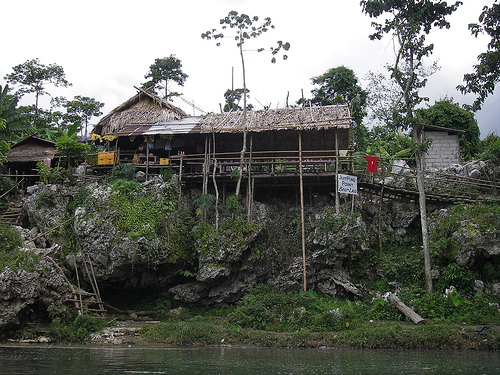
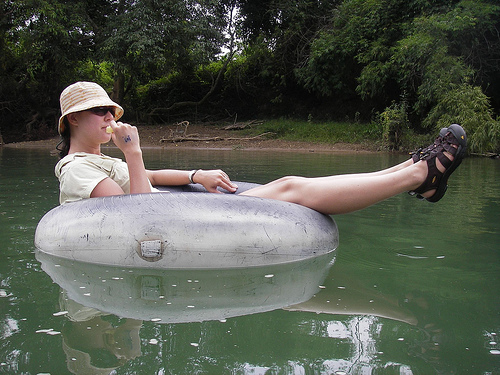
But the prize is really the karsts (and caves contained therein), which to me have an only-in-asia feel...
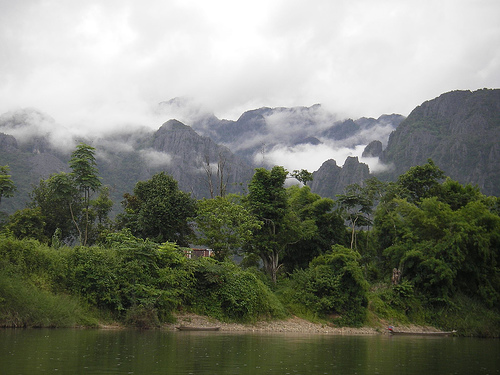
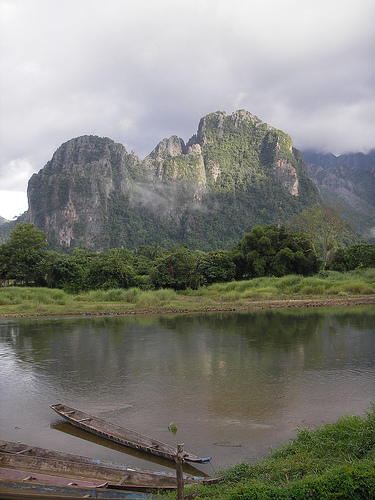
Laos is a beautiful and mostly untouched place and I hope that it can stay that way.
River Rafting near Luang Prabang Laos
Like so many of the things we do, the journey is so much better than the destination. This was certainly the case when we decided to go river rafting in
The day began with the precarious stacking of various river floating paraphernalia on top of an open air truck called a song tao (phonetic spelling) and meeting two of the more unfriendly travelers we’ve met thus far. Funny thing, their noses seemed to be permanently lifted into the air to such a degree that they found it unnecessary to interact with the likes of us. We could only chuckle in our bewilderment.

It was really more like river floating or river paddling than river rafting, I’d say. The rapids were surely class 1 and we spent much of the time paddling through nearly stagnant yoo-hoo colored water. In fact, on a couple of occasions, our trusty guides Pon and Jon napped (as is apparently customary in SE Asia). All the clothes below are for protection from the sun.

The fun began when we stopped to have lunch at a small 300 person village. As we pulled up on the banks of the river, the kids from the village came down to greet us. For the next hour or so we all played in the river and my camera, or the images it produced, was often the center of attention. They laughed so hard when they saw the picture below.


The guides gave them a little help in the air too.
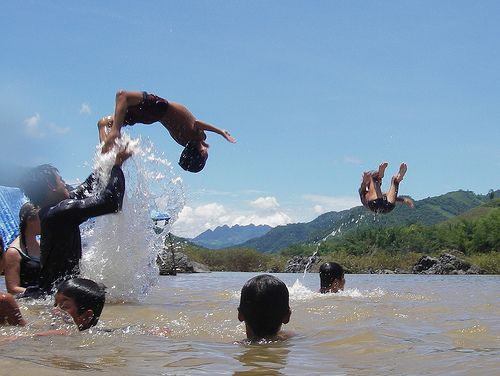
The girls from the village were a bit more reserved.

We got thankfully separated from the other group and in our time waiting for them, Jon saw his cousin on the river and they invited us to the shore for a fish fry.

We pulled up on the banks as his family and friends proceeded to make a fire, set up a table and serve a freshly caught meal of river fish, stewed vegetables, pumpkin seeds, sticky rice and plenty of “lao-lao” or homemade Lao Whiskey. The whiskey is akin to moonshine, but made from sticky rice. They made us feel right at home.

Though the rafting itself wasn’t that exciting, the scenery was amazing and we didn’t need to remind ourselves that we’re floating down a river somewhere in the middle of

Looking around, it really felt like something from a movie with village fisherman, kids playing on the beach and not a speck of modern civilization in sight. It was surely some of the best

Luang Prabang, Laos

We didn’t know what to expect from

Loas, like it’s brothers in

With a number of wats (temples) it is nearly impossible to move around without seeing young monks. Our guesthouse is directly across the street from a wat and every morning at

The mighty Mekong

A plumeria on the way up Mount Phousi Hill in the middle of the city...
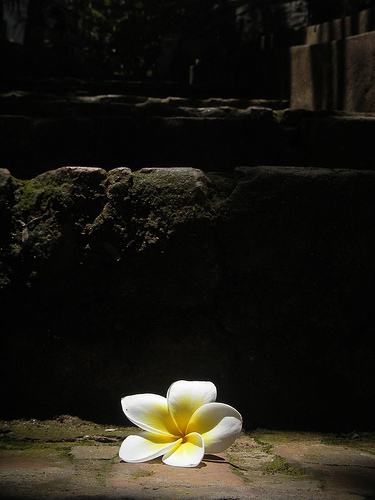



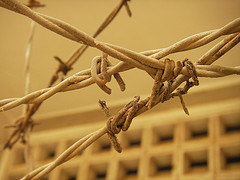
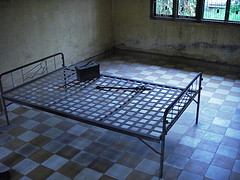



Recent comments
1 year 27 weeks ago
1 year 31 weeks ago
1 year 31 weeks ago
1 year 37 weeks ago
1 year 44 weeks ago
1 year 47 weeks ago
2 years 2 weeks ago
2 years 9 weeks ago
2 years 9 weeks ago
2 years 12 weeks ago